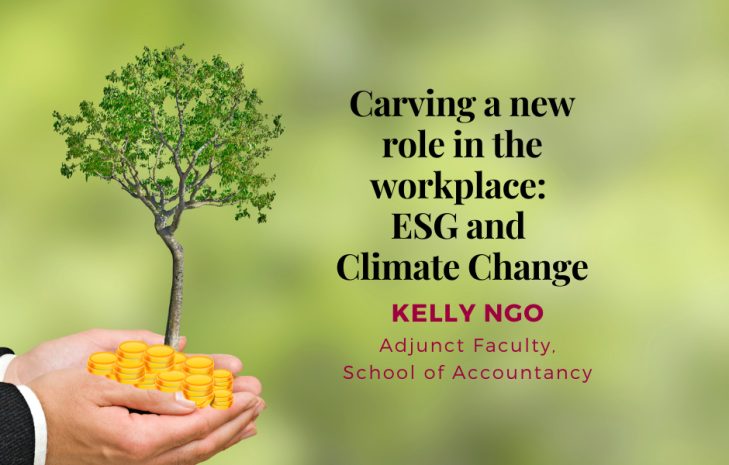Risk disclosures and frameworks pave the way for Sustainability Reporting
Risk disclosures and frameworks pave the way for Sustainability Reporting

The repercussions of climate change are undeniable as natural disasters continue to disrupt lives and livelihoods around the world. Increasingly, key stakeholders are shifting their focus to ensure that solutions for environmental issues that plague the planet are now part of business fundamentals and strategies. Therefore, in order to thrive in uncertainty and volatility, businesses will need to incorporate sustainability efforts into their operations, making sustainability reporting in accounting even more important today.
Speaking at a recent masterclass titled ESG & Climate Change, jointly organised by SMU Accounting Masters and CPA Australia, Ms. Kelly Ngo, Adjunct Faculty, shared on the impact of ESG factors on accounting reporting, particularly sustainability reporting, and how to navigate the changes underway.
“Over the next few years, the physical impacts from climate change will eventually force all of us to transition rapidly away from the use of fossil fuels, just to stop further defecation to the climate. This, I believe, in turn, will have a ripple effect across the economy, because we are looking at entire value chains that are currently relying on fossil fuels,” said Ms. Ngo.
It then raises the question of whether financial markets be able to avoid being blindsided by the climate risk. Dubbed as “a market solution by the market and for the market”, Ms. Ngo continued that risk disclosures are the way forward, particularly to address climate change.
“Michael Bloomberg of Task Force for Climate-related Financial Disclosure (TCFD) pointed out that early disclosure rules allowed for the 20th century financial markets to grow our economies, by pricing risk more accurately… Disclosures are a small step to help to set into motion larger changes through market forces,” said Ms. Ngo.
Additionally, at the recent 2021 United Nations Climate Change Conference (COP26) in November, one of the very ambitious commitments that that the countries took on was to make clean, sustainable solutions, the most affordable, accessible and the most attractive options for all sectors including energy and transport. On top of that, under the tenant of collaboration, the countries have formed an agreed table of enhanced transparency framework, which allows nations to work together in tracking and communicating emissions and support towards greening efforts and actions taken.
Closer to home, Ms. Ngo pointed out that in line with Singapore’s green plan vision to becoming the leading centre for green finance in Asia and the world, the government has implemented a broad-based carbon tax to encourage the transition to a low carbon economy, supporting projects that help enterprises reduce greenhouse gas emissions.
“Homegrown innovations will also be encouraged under the Research, Innovation and Enterprise 2025 Plan, as the country hopes to attract companies to anchor their R&D activities in Singapore to develop sustainable solutions for the world,” Ms. Ngo added.
As well, the Singapore stock exchange (SGX) now requires a listed issuer to prepare an annual sustainability report, which must describe the issuer’s sustainability practice with reference to a set of primary components on a ‘comply or explain’ basis. Simply put, when an issuer cannot report on any primary component, they would need explain what alternative measures are taken and the reasons behind them.
While still considered voluntary, climate reporting for some sectors, such as energy and transportation, will be made mandatory by 2023, with more sectors to be included by 2024.
With these changes afoot, it becomes more crucial to stay on top of sustainability efforts throughout the business. Supporting these developments are a range of frameworks that provide guidelines to help enterprises adapt and stay resilient across borders and jurisdictions.
“Currently, in financial reporting part the statement of financial position and the statement of comprehensive income provides a snapshot of the present and an account of the past. But together with the sustainability report, which will now showcase all ESG factors, this will help show the risks and opportunities within sight that is managed for future returns. This will give us a complete overview of the past, present and future and will enable a better assessment of the issuers’ financial prospects and the quality of the management,” Ms. Ngo said.
Three of the main frameworks that Ms. Ngo highlighted were by the Global Reporting Initiative (GRI), the Sustainability Accounting Standards Board (SASB) and the International Integrated Reporting Council (IIRC) - all of which complement each other.
GRI framework, which is used by over 80% of the world's 250 largest corporations, remains the most widely used global reporting framework across ESG factors for a whole host of stakeholders, including investors, making it the safest bet to cover a variety of audience, such as customers, employees or non-governmental organisations, Ms. Ngo explained.
The SASB (Sustainability Accounting Standards Board) issues standards that focuses on how sustainability issues will impact the company and financial performance. With 77 industry classifications or categories it has developed standards for, along with materiality maps, this would be particularly helpful for newer reporters, she continued.
The IIRC’s integrated reporting framework is a little different, by focusing on how the entity has created value, how it is intending to preserve the value and how it is preventing an erosion of this value in the short, medium and long terms. International global investors, lenders and insurance are the primary audience for these reports.
To help streamline reporting standards, the Financial Stability Board (FSB) set up the industry led TCFD in 2015, to establish a framework that applies to listed equity and debt instrument companies.
“In fact, the other standards are working to align their standards with the recommendations set by TCFD. This is to have consistent disclosures to help financial market participants understand their climate-related risk.
“It also lets stakeholders better understand where the concentration of carbon-related assets in the finance sector is, the financial system’s exposure to climate-related risk, and the disclosure by the finance sector, in particular, will foster an early assessment of this risk. Because if you know it's been priced in, the market can see the price difference between a company doing well to adapt versus a company that’s not doing much. This facilitates a sort of market discipline, so that financing or capital will flow to the more resilient companies,” Ms. Ngo clarified.
With the transition into a low carbon economy underway, these initiatives, along with more transparency on greening efforts and sustainability commitments, look set to address both the environmental and business challenges as a result climate change. Incorporating climate-related risk into assets would no doubt improve efficient capital allocations as well as boost the human capital required to operationalise these new reporting requirements.
“By appraising the risk accurately, the market will be able to reward companies that are actively taking appropriate steps to prepare and adapt themselves, and can also unlock financing for these companies that are considered resilient. And so, climate risk disclosures are an opportunity, as well as a necessity for the markets to accelerate both the energy transition into green energy and to prepare for growing climate impacts,” quipped Ms. Ngo.
To sign up for more SMU Accounting Masters' Events, visit: https://accountancy.smu.edu.sg/events.






